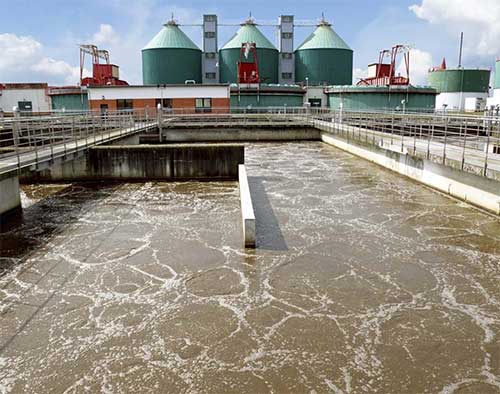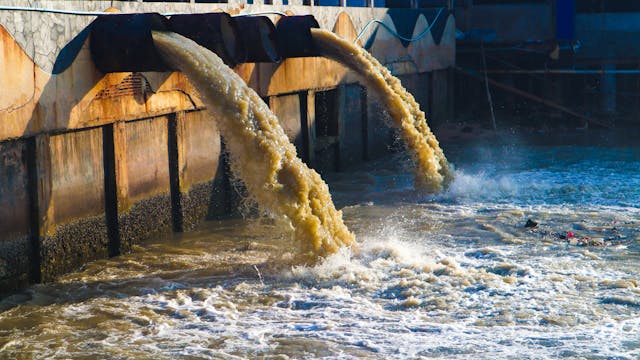Secret Techniques in Industrial Waste Water Treatment Procedures
The therapy of industrial wastewater is a vital element of environmental management, entailing a variety of strategies developed to alleviate the influence of contaminants. Developments in innovations such as membrane layer filtering and advanced oxidation procedures offer innovative options for enhancing treatment efficacy.
Physical Therapy Methods
How effectively can physical treatment techniques deal with the complexities of industrial wastewater? Physical treatment methods play an essential function in the preliminary phases of wastewater administration, focusing largely on the elimination of solids and large particulates. Techniques such as filtering, sedimentation, and flotation are vital for minimizing the concentration of put on hold solids, thus improving the effectiveness of subsequent therapy procedures.
Sedimentation entails the gravitational settling of solids, enabling for the separation of heavier products from the wastewater. This method is especially reliable in clarifying water prior to chemical or biological therapies.
In addition, flotation protection techniques, which use air bubbles to lift put on hold solids to the surface for removal, work in dealing with wastewater with high concentrations of fats, oils, and greases. On the whole, physical treatment techniques function as a crucial initial step in the detailed management of commercial wastewater, making sure that the load on subsequent treatment phases is lessened and improving general treatment effectiveness.
Chemical Treatment Strategies
While physical therapy approaches prepared for efficient wastewater monitoring, chemical therapy methods are necessary for resolving the more complicated impurities typically located in commercial effluents. These approaches use numerous chemical agents to precipitate, reduce the effects of, or oxidize dangerous substances, making sure a much more comprehensive elimination of contaminants.
One typical technique is coagulation and flocculation, where chemical coagulants such as light weight aluminum sulfate or ferric chloride are contributed to promote the gathering of put on hold fragments. This procedure improves solid-liquid splitting up, decreasing turbidity and boosting water quality. Additionally, neutralization processes are used to adjust the pH of wastewater, utilizing bases or acids to neutralize acidic or alkaline streams, specifically.
Oxidation-reduction reactions play an essential duty in derogatory organic pollutants and pathogens. Chemical oxidants like chlorine, hydrogen, or ozone peroxide are used to break down intricate natural compounds, making them less hazardous or a lot more eco-friendly. Progressed oxidation processes (AOPs) incorporate multiple oxidation techniques to boost pollutant elimination efficiency.
Biological Therapy Procedures
The efficiency of wastewater treatment is considerably improved by biological treatment procedures, which harness the all-natural metabolic activities of bacteria to disintegrate raw material and remove pollutants. Industrial Waste Water Treatment. These procedures mostly involve aerobic and anaerobic food digestion, each tailored for particular types of wastewater
Cardiovascular therapy procedures make use of oxygen to sustain microbial growth, advertising the breakdown of natural contaminants into co2 and water. Typical techniques include triggered sludge systems, where oygenation storage tanks assist in the blending of wastewater with microbes, and flowing filters, which urge biofilm development on media surface areas.
On the other hand, anaerobic therapy processes find out here now take place in the lack of oxygen, utilizing anaerobic microorganisms to decay raw material, leading to biogas manufacturing, a renewable resource source. Anaerobic digesters are commonly utilized in industrial setups for this purpose, properly minimizing the volume of sludge while generating valuable biogas.
The option of an organic treatment method relies on wastewater attributes, therapy goals, and regulative requirements. The integration of organic processes in wastewater treatment not just enhances toxin removal performance yet likewise promotes sustainability by minimizing chemical use and supporting resource recuperation.
Advanced Oxidation Processes

Usual AOP techniques consist of Fenton's photocatalysis, reagent, and ozonation. Fenton's reagent, a mix of hydrogen peroxide and ferrous iron, militarizes the formation of hydroxyl radicals, making it efficient for dealing with wastewater containing phenolic substances and various other stubborn compounds. Ozonation makes use of ozone as a powerful oxidant, with the ability of degrading a large range read here of organic pollutants while all at once disinfecting the effluent. Photocatalysis employs light-activated stimulants, such as titanium dioxide, to enhance oxidation reactions and get rid of contaminants.
AOPs provide several benefits, including lowered sludge manufacturing and the ability to treat wastewater with high concentrations of organic toxins. The implementation of AOPs requires careful consideration of functional parameters and cost-effectiveness, ensuring that these sophisticated methods are suitably integrated right into existing wastewater therapy systems.
Membrane Purification Technologies

Microfiltration works for getting rid of suspended solids and microorganisms, while ultrafiltration targets smaller organic molecules and infections. Nanofiltration bridges the void between ultrafiltration and turn around osmosis, successfully removing organic substances Check This Out and divalent ions. Reverse osmosis provides the greatest level of filtration, made use of primarily for desalination and removing mono-valent ions.
Membrane innovations offer many benefits, including reduced power consumption compared to typical treatment approaches, modular layout for scalability, and the capacity for water recovery and reuse. Nevertheless, challenges such as membrane fouling and the requirement for routine upkeep have to be resolved to make sure system efficacy. Overall, membrane layer filtering technologies stand for a crucial component of modern industrial wastewater therapy strategies, advertising sustainability and source preservation in water management.
Final Thought
In conclusion, industrial wastewater treatment employs a diverse selection of techniques, consisting of physical, chemical, organic, and progressed approaches. Continued advancements in these techniques will even more improve the efficiency and efficiency of wastewater treatment processes in industrial setups.
The treatment of industrial wastewater is an important element of ecological management, involving a variety of techniques developed to alleviate the influence of pollutants.How properly can physical treatment techniques deal with the intricacies of industrial wastewater?Advanced oxidation procedures (AOPs) stand for a sophisticated technique in industrial wastewater treatment, developed to successfully break down organic toxins that are often immune to traditional treatment approaches (Industrial Waste Water Treatment).In conclusion, commercial wastewater treatment employs a varied variety of methods, consisting of physical, chemical, organic, and progressed methods. Proceeded innovations in these methods will certainly additionally improve the performance and performance of wastewater therapy processes in commercial setups